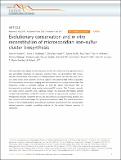Files in this item
Evolutionary conservation and in vitro reconstitution of microsporidian iron-sulfur cluster biosynthesis
Item metadata
| dc.contributor.author | Freibert, Sven-A | |
| dc.contributor.author | Goldberg, Alina V. | |
| dc.contributor.author | Hacker, Christian | |
| dc.contributor.author | Molik, Sabine | |
| dc.contributor.author | Dean, Paul | |
| dc.contributor.author | Williams, Tom A. | |
| dc.contributor.author | Nakjang, Sirintra | |
| dc.contributor.author | Long, Shaojun | |
| dc.contributor.author | Sendra, Kacper | |
| dc.contributor.author | Bill, Eckhard | |
| dc.contributor.author | Heinz, Eva | |
| dc.contributor.author | Hirt, Robert P. | |
| dc.contributor.author | Lucocq, John Milton | |
| dc.contributor.author | Embley, T. Martin | |
| dc.contributor.author | Lill, Roland | |
| dc.date.accessioned | 2017-01-06T16:30:09Z | |
| dc.date.available | 2017-01-06T16:30:09Z | |
| dc.date.issued | 2017-01-04 | |
| dc.identifier | 247379075 | |
| dc.identifier | 0c241fa6-c6db-48d1-832f-67927ffd6e99 | |
| dc.identifier | 85008352113 | |
| dc.identifier | 000391127800001 | |
| dc.identifier.citation | Freibert , S-A , Goldberg , A V , Hacker , C , Molik , S , Dean , P , Williams , T A , Nakjang , S , Long , S , Sendra , K , Bill , E , Heinz , E , Hirt , R P , Lucocq , J M , Embley , T M & Lill , R 2017 , ' Evolutionary conservation and in vitro reconstitution of microsporidian iron-sulfur cluster biosynthesis ' , Nature Communications , vol. 8 , 13932 . https://doi.org/10.1038/ncomms13932 | en |
| dc.identifier.issn | 2041-1723 | |
| dc.identifier.other | ORCID: /0000-0002-5191-0093/work/64361218 | |
| dc.identifier.uri | https://hdl.handle.net/10023/10060 | |
| dc.description | This work was supported by Marie Curie Postdoctoral Fellowships to T.A.W., E. H. and S. L., a European Research Council Advanced Investigator Grant (ERC-2010-AdG-268701) to T.M.E., and a Wellcome Trust Programme Grant (number 045404) to T.M.E. and J.M.L. R.L. acknowledges generous financial support from Deutsche Forschungsgemeinschaft (SFB 593, SFB 987, GRK 1216, LI 415/5), LOEWE program of state Hessen, Max-Planck Gesellschaft, von Behring-Röntgen Stiftung | en |
| dc.description.abstract | Microsporidians are a diverse group of obligate intracellular parasites that have minimized their genome content and simplified their sub-cellular structures by reductive evolution. Functional studies are limited because we lack reliable genetic tools for their manipulation. Here, we demonstrate that the cristae-deficient mitochondrion (mitosome) of the microsporidian Trachipleistophora hominis is the functional site of iron-sulphur cluster (ISC) assembly, which we suggest is the essential task of this organelle. Cell fractionation, fluorescence imaging and fine-scale immunoelectron microscopy demonstrate that mitosomes contain a complete pathway for [2Fe-2S] cluster biosynthesis that we biochemically reconstituted using purified recombinant mitosomal ISC proteins. Reconstitution proceeded as rapidly and efficiently as observed for yeast or fungal mitochondrial ISC components. Core components of the T. hominis cytosolic iron-sulphur protein assembly (CIA) pathway were also identified including the essential Cfd1-Nbp35 scaffold complex that assembles a [4Fe-4S] cluster as shown by spectroscopic methods in vitro. Phylogenetic analyses reveal that both the ISC and CIA biosynthetic pathways are predominantly bacterial, but their cytosolic and nuclear target Fe/S proteins are mainly archaeal. This mixed evolutionary history of the Fe/S-related proteins and pathways, and their strong conservation among highly reduced parasites, provides additional compelling evidence for the ancient chimeric ancestry of eukaryotes. | |
| dc.format.extent | 12 | |
| dc.format.extent | 4272492 | |
| dc.language.iso | eng | |
| dc.relation.ispartof | Nature Communications | en |
| dc.subject | QR Microbiology | en |
| dc.subject | QH301 Biology | en |
| dc.subject | RB Pathology | en |
| dc.subject | NDAS | en |
| dc.subject | BDC | en |
| dc.subject | R2C | en |
| dc.subject.lcc | QR | en |
| dc.subject.lcc | QH301 | en |
| dc.subject.lcc | RB | en |
| dc.title | Evolutionary conservation and in vitro reconstitution of microsporidian iron-sulfur cluster biosynthesis | en |
| dc.type | Journal article | en |
| dc.contributor.institution | University of St Andrews. School of Medicine | en |
| dc.contributor.institution | University of St Andrews. Cellular Medicine Division | en |
| dc.contributor.institution | University of St Andrews. Biomedical Sciences Research Complex | en |
| dc.identifier.doi | 10.1038/ncomms13932 | |
| dc.description.status | Peer reviewed | en |
| dc.date.embargoedUntil | 2017-01-04 |
This item appears in the following Collection(s)
Items in the St Andrews Research Repository are protected by copyright, with all rights reserved, unless otherwise indicated.

